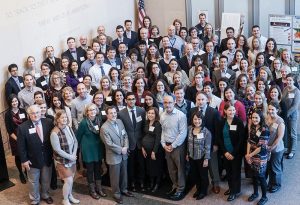Thalidomide – New modeling algorithm & mechanism of ac
Greetings all:
Michelle James initiated a discussion on a recent paper on thalidomide and Ann thought it would be good to share.
Modeling algorithm for thalidomide embryopathy (TE)
A recent article by Mansour et al., 2018 (JSHE) DOI: 10.1177/1753193418800631 outlines an interesting approach to determine if the pattern of malformations is indeed TE rather than a genetic phenocopy of the disorder. They did meticulous work on correlating patterns of malformations with TE using original literature. The authors correlated the timing of disruption and specific patterns of malformation across organ systems, not just the limbs, that implicate thalidomide. This may well be a clue to the mechanism of TE – what genes or pathways are disrupted at these times during gestation within these target tissues (See below). The comparison with genetic phenocopies will also be helpful at understanding the pathways disrupted by thalidomide.
This is not unlike the patterns we associate with different genes that affect unique targets (Baas et al., 2017 J Hand Surg Am. 2017. 42(7):533-545.e4.), however, TE does not have the luxury of a good animal model to verify causality. So this type of multiple organ system data collection is an important way to tackle an underlying malformation that may have a pathway disruption or epigenetic mechanism (that could be inherited even if not genetic) that is eluding discovery by genomic approaches.
As with the “CULAPhen” software proposed by Baas (2017) that prioritizes diagnosis and testing, it looks like DATE software is still under development. I believe these types of software programs if available on the web, would be a significant advantage to the field.
Mechanism of thalidomide embryopathy (TE) – SALL4 target of thalidomide degradation
A paper out last month by Donavan et al. (2018) suggest that TE is related to SALL4 degradation. They have compelling data that demonstrated human and rabbit SALL4 are targets of thalidomide degradation, while subtle changes in the sequence of rodent Sall4 changes the ability of thalidomide to target Sall4 for degradation. Human/Rabbit have a Valine at aa 388, while rodents have Isoleucine. The finding has prompted Science to release a science news note stating that “After 60 years Scientist uncover how thalidomide causes birth defects.”(https://www.sciencedaily.com/releases/2018/08/180801131524.htm).
Ref: Donavan et al., 2018 eLife 2018;7:e38430. DOI: 10.7554/eLife.38430
Kerby
Kerby C. Oberg, MD, PhD
Professor
Senior Administrative Associate, Division of Human Anatomy
Scientific Director, SM Summer Research Program
Attending, Division of Pediatric Pathology
